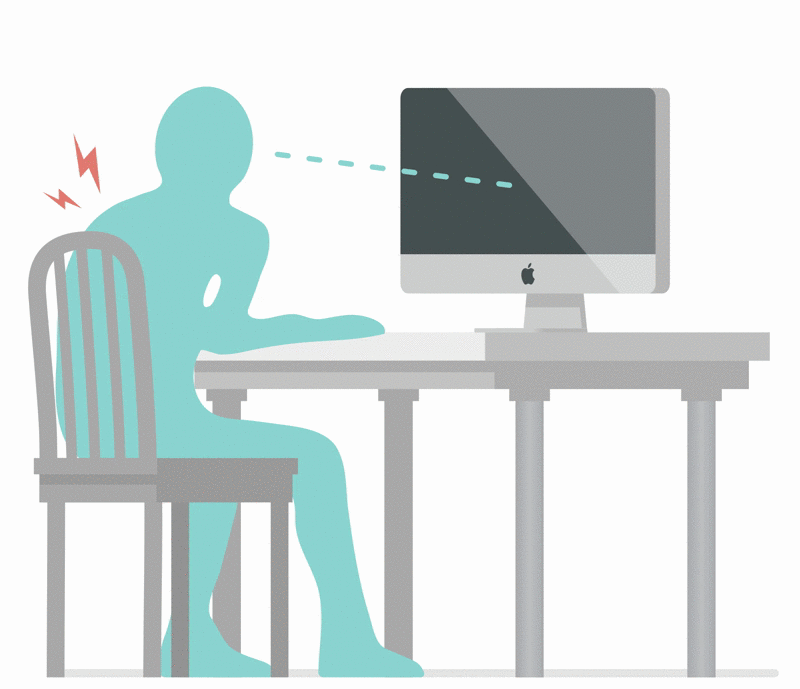All About Chairs
If you’re looking for home office chair ideas, you don’t have to go far. The New York Times, Gear Patrol, Tom’s Guide. They give solid product recommendations based on materials, style, function, ergonomics, etc. Beyond calling out some top picks here, we’ll also explore what the purpose of a chair is, and how it fits into your workspace, your workflow, and your work-happiness.
Basics: Elements of Ergonomics
The chair. A tantalizing design problem. A symbol of civilization. A sign of sophistication. Also, just pretty convenient. Even a bad chair has its perks. But a good chair? A good chair receives you gracefully and lets you go with ease. It lets you rest but keeps you from slouching into disrepair and despair. Good posture, after all, is an inside-out affair.
Take a moment to relax your shoulders, sit up, plant your feet on the floor. Set your body right, see how your mind follows. Sure you can do good work in a bad chair. But we propose that with a good chair you can do great work. And stay healthy while you’re at it.
What else makes a good chair?
Good Chair (noun):
Take a moment to relax your shoulders, sit up, plant your feet on the floor. Set your body right, see how your mind follows. Sure you can do good work in a bad chair. But we propose that with a good chair you can do great work. And stay healthy while you’re at it.
What else makes a good chair?
Good Chair (noun):
- A chair that looks nice while also letting the award-winning design of the human body realize its full potential.
- A chair that you absolutely love and simply can’t work without.
Elegant Design: The Human Body
We are made to move, and we do better when we do. We also are made to rest. This doesn’t mean hunching over a surface and squinting at a screen. Sure it’s ok to sit, but make it count. Let your spine be at ease in its gentle S shape, let that ball and socket hip joint be ready to roll, let your shoulders fall and your head stay erect, alert. Ideally this position creates a line from hip joint to shoulders to head. And we all know the beauty of a good line!

If we sit with a posture that complements our body’s natural construction, it’s much easier to:
But also, in addition to sitting with good posture, it’s good to move around and mix it up whenever you can. “Good” posture for eight straight hours isn’t good anymore. Take it from Galen Cranz, a Professor Emerita of Architecture at UC Berkeley. She wrote a book in 1998 that challenged The Chair (The Chair: Rethinking Culture, Body, and Design), and challenged the culture it sits on and that sits on it. As she explained in this interview with Portland Spaces, our bodies need variety. We need lounge positions, squat positions, kneeling positions. We need workspaces that invite and encourage this kind of progressive approach to work, where it’s ok to “lay down on the job.”
- Avoid injury and strain
- Activate your internal systems, like your core and glute muscles, and your diaphragm, and your spine-spinal cord-nervous system
- Feel confident and engaged
But also, in addition to sitting with good posture, it’s good to move around and mix it up whenever you can. “Good” posture for eight straight hours isn’t good anymore. Take it from Galen Cranz, a Professor Emerita of Architecture at UC Berkeley. She wrote a book in 1998 that challenged The Chair (The Chair: Rethinking Culture, Body, and Design), and challenged the culture it sits on and that sits on it. As she explained in this interview with Portland Spaces, our bodies need variety. We need lounge positions, squat positions, kneeling positions. We need workspaces that invite and encourage this kind of progressive approach to work, where it’s ok to “lay down on the job.”

But hey, you’re working from home! So you can go as progressive as you like. Work on an LC4 lounge chair or other recliner chair for an interval, switch over to an adjustable desk chair, find a place to drop into a squat. This should relieve a little pressure, physically and emotionally: not only is your body at ease, but your chair decision just became much less weighty. You’re not looking for a piece that’s going to be comfortable from punch-in to punch-out. You’re looking for a piece that:
- Encourages good posture while you sit in it
- You love
- Looks good in your space
- Fits into a broader seating plan
Chair Elements
With that in mind, let’s consider the following, question-answer style.
Is a back support important on an office chair?
Yes, with caveats. “Back support” sometimes causes you to rely too much on the support, not enough on your own capabilities. It might actually be better to start with a backless seat. I.E. a stool. On the high end, this Artek Alvar Aalto four-legged stool is cool.
Is a back support important on an office chair?
Yes, with caveats. “Back support” sometimes causes you to rely too much on the support, not enough on your own capabilities. It might actually be better to start with a backless seat. I.E. a stool. On the high end, this Artek Alvar Aalto four-legged stool is cool.
Aalto originally designed a three-legged stool in the early 1930s, using birch for the legs since it was a widely-available resource in his native Finland. That’s reason number one we can get behind the stool, given how much we love our wood here at Grovemade. Aalto also (progressively, at that time) bent the wood to make beautiful, curved legs. And there’s reason number two: we love a good curve as much as we love a good line.

You can read a little more about Aalto’s classic stool at Culture Trip, but for a color pop at a lower price, check out these accent stools.
If you get a backed chair, make sure you can keep that S-shape spine when you sit all the way in it. If you need to refresh your muscle memory, try sitting on the front edge for a spot.
For extra back support, here’s a roundup of lumbar support pillows that can help you to keep that core engaged and avoid a C-shape spine.
If you get a backed chair, make sure you can keep that S-shape spine when you sit all the way in it. If you need to refresh your muscle memory, try sitting on the front edge for a spot.
For extra back support, here’s a roundup of lumbar support pillows that can help you to keep that core engaged and avoid a C-shape spine.

Of course it’s good to make sure that your stool/ chair height complements your desk height and allows you to maintain that easy position. Posture is a system, and the seat is only one component.
Is a hard or soft chair ergonomically better for desk jobs?
Hard-ish. A firm chair provides better support. A soft chair lets you sink too easily into a crumpled, unengaged posture, also causing you to tense your muscles more as you try to stay erect. Check out this article by SecretLab, a chair company started by two gamers who saw a need for better gaming chairs. Rounds and rounds of R&D have led them to produce adjustable, medium-firm chairs that can stand up to long hours of gaming. Like this Secretlab OMEGA.
What about “gimmicky” chairs?
Ergonomic chairs are fine tuned to keep your body in a healthy, safe position. A good ergonomic chair is adjustable, allowing you to customize to your physical build. It’s cushioned, but not too soft, and it has a stable base.
For an ergonomic dream chair, check out this Capisco Chair by designer Peter Opsvik, or his updated version, the Capisco Puls Chair. Opsvik was originally inspired by a horseback rider’s posture when first designing the chair. But he didn’t stop there. Opsvik, like Cranz, believes that “good posture” means regularly changing your position and posture. You can hear him talk about it in this two minute video, which begins with him playing saxophone! Anyway, the Capisco lets you sit facing forward, to the side, to the back, high, low, any which way you want to go, basically. A really good ergonomic chair should adapt, allowing you to sit in a variety of ways.
If you’re on a tighter budget and a Capisco Chair isn’t on the table, you can find a nifty ergo-setup checklist by ViewSonice here.
A tailored, ergonomic chair can have all sorts of good downstream effects: increased productivity, better physical health, better mood, lower health costs. In a nutshell, a good one can make work and life a lot more enjoyable.
Is a hard or soft chair ergonomically better for desk jobs?
Hard-ish. A firm chair provides better support. A soft chair lets you sink too easily into a crumpled, unengaged posture, also causing you to tense your muscles more as you try to stay erect. Check out this article by SecretLab, a chair company started by two gamers who saw a need for better gaming chairs. Rounds and rounds of R&D have led them to produce adjustable, medium-firm chairs that can stand up to long hours of gaming. Like this Secretlab OMEGA.
What about “gimmicky” chairs?
Ergonomic chairs are fine tuned to keep your body in a healthy, safe position. A good ergonomic chair is adjustable, allowing you to customize to your physical build. It’s cushioned, but not too soft, and it has a stable base.
For an ergonomic dream chair, check out this Capisco Chair by designer Peter Opsvik, or his updated version, the Capisco Puls Chair. Opsvik was originally inspired by a horseback rider’s posture when first designing the chair. But he didn’t stop there. Opsvik, like Cranz, believes that “good posture” means regularly changing your position and posture. You can hear him talk about it in this two minute video, which begins with him playing saxophone! Anyway, the Capisco lets you sit facing forward, to the side, to the back, high, low, any which way you want to go, basically. A really good ergonomic chair should adapt, allowing you to sit in a variety of ways.
If you’re on a tighter budget and a Capisco Chair isn’t on the table, you can find a nifty ergo-setup checklist by ViewSonice here.
A tailored, ergonomic chair can have all sorts of good downstream effects: increased productivity, better physical health, better mood, lower health costs. In a nutshell, a good one can make work and life a lot more enjoyable.
SEAN'S PICK: HERMAN MILLER COSM CHAIR
This chair doesn’t have levers and knobs. Instead it has “Auto-Harmonic Tilt” that responds to your particular structure. It provides continuous support for spine support, is breathable, and has a thin, flexible frame. It comes in low, mid and high back versions!
This chair doesn’t have levers and knobs. Instead it has “Auto-Harmonic Tilt” that responds to your particular structure. It provides continuous support for spine support, is breathable, and has a thin, flexible frame. It comes in low, mid and high back versions!


Ball “chairs” are good to have on hand when it’s time to step out of your seat and roll around a little, bounce a bit. As we mentioned above, Cranz is a fan of having a ball option around. There’s also this ball-stool hybrid that, pleasantly, looks kind of like a mushroom: Dome Ballo Active Stool. Anyway, if you go with a classic yoga ball chair, make sure it’s fully inflated and is a good size for your body, meaning your knees aren’t sitting higher than your hips. Engage your core, and attend to your posture—it’s still possible to slouch and collapse on a yoga ball!

We notice some recurring themes as we come to the close of our time here:
- Make sure your seat-of-choice is a good size and good fit for you.
- Make sure it’s at a good height relative to your desk.
- Keep your spine in it’s natural S-shape and work that core! Mix it up.
Addendum 01
To maximize your good chair’s potential, consider these complementary assets:
- Laptop lift and/ or monitor riser so you’re head isn’t drooping down to see the screen and your body isn’t hunched.
- Foot riser or sling to prop your feet up and ensure a consistent, comfortable leg angle. Wirecutter likes the ErgoFoam Adjustable Foot Rest and the Humanscale FR300 Foot Rocker. Check out their list for more ideas.
- Balance board, if you’re standing at your desk. Like The Level from Fluidstance.
Addendum 02
Sean’s picks! Our Lead Designer took a minute to run through his favorite desk chair options. Disclaimer: these are not certified posture-improvers. They bring joy to Sean.






